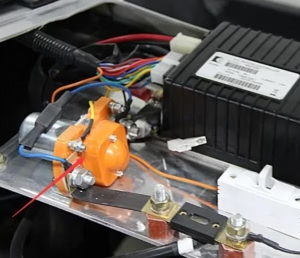As a seasoned golf cart specialist, I’ve witnessed firsthand how solenoids are the unsung heroes of electric golf cart operation. These small components might seem insignificant, but they’re the gatekeepers that control the electrical power flowing to your cart’s motor. Without properly functioning solenoids, your golf cart would be nothing more than an immovable object on the course. This comprehensive guide dives deep into the world of golf cart solenoids, exploring their functionality, common issues, and effective solutions.
The Mechanics of Golf Cart Solenoids
At first glance, golf cart solenoids might appear simple, but their operation is quite sophisticated. Let’s break down the key components and how they work together:
Key Components
-
Solenoid Coil: This wire coil is the powerhouse of the solenoid. When electricity passes through it, it creates a magnetic field that sets the whole system in motion.
-
Plunger: Attached to the coil, this movable metal rod responds to the magnetic force, moving to either complete or interrupt the electrical circuit.
-
Contacts: These are the critical connection points that either allow or block electricity from flowing to the motor.
-
Housing: This protective casing shields the delicate internal components from environmental factors.
How It All Works
When you turn the ignition switch:
-
Electricity flows through the solenoid coil, generating a magnetic field.
-
The magnetic field pulls or pushes the plunger, which in turn closes the electrical contacts.
-
With the contacts closed, electricity can flow freely from the battery to the motor, bringing your golf cart to life.
-
When you turn off the ignition, the current to the solenoid stops, the magnetic field disappears, and the plunger returns to its resting position, opening the contacts and stopping the electricity flow.
When Things Go Wrong: Common Solenoid Issues
Even the most durable components can succumb to wear and tear. Here are the most common problems golf cart owners might encounter with their solenoids:
1. No Start Situation
One of the most obvious signs of a failing solenoid is when your golf cart refuses to start. This usually happens because the solenoid isn’t engaging properly, blocking the vital electricity flow from the battery to the motor. Potential culprits include corroded contacts, a worn-out plunger, or a faulty solenoid coil.
2. Stop-and-Go Performance
If your golf cart starts and stops unexpectedly or runs for a short period (often around 15 minutes) before quitting, solenoid issues could be to blame. Dirty or corroded contacts can disrupt electricity flow, while loose connections or a weakened solenoid coil can lead to inconsistent performance.
3. The Annoying Click
Hearing clicking sounds when attempting to start your golf cart is another common indicator of solenoid problems. These clicks signal that the solenoid is trying but failing to engage fully. Causes might include corroded contacts, a weak solenoid coil, or a faulty plunger that isn’t making proper contact.
Solving Solenoid Problems: A Systematic Approach
Addressing solenoid issues requires a methodical approach. Here’s how to diagnose and resolve problems effectively:
Step 1: Battery Voltage Check
Before diving into the solenoid itself, check your battery’s voltage using a multimeter. Insufficient voltage can cause solenoid failure or poor performance. Ensure the battery is charged and capable of delivering the required power.
Step 2: Connection Inspection
Examine all electrical connections related to the solenoid. Look for signs of corrosion, oxidation, or looseness. Clean any corroded terminals with a wire brush and tighten all connections. Secure, clean connections are essential for efficient electricity flow.
Step 3: Solenoid Functionality Test
Disconnect the solenoid wires and use a multimeter set to continuity or resistance mode to test the solenoid. Apply power while testing continuity across the terminals. If you detect an open circuit or excessive resistance, your solenoid might need replacement.
Step 4: Contacts and Plunger Examination
Inspect the solenoid’s contacts for wear, pitting, or burning. Check the plunger for damage that could impede its movement. Clean the contacts and plunger with a mild solvent or electrical contact cleaner if necessary.
Step 5: Replacement Decision
If your solenoid fails any of the tests or shows significant damage, it’s time for replacement. Purchase a compatible solenoid from a reputable supplier and follow manufacturer instructions for installation. If you’re unsure about the repair process, don’t hesitate to consult a certified technician.
Keeping Your Solenoid in Top Shape: Preventative Maintenance
Regular maintenance is your best defense against unexpected solenoid failures. Here are some proactive steps to keep your solenoid functioning optimally:
1. Clean Connections
Regularly inspect and clean all electrical connections associated with the solenoid. Use appropriate tools to remove corrosion or oxidation. Clean connections ensure efficient electricity flow and prevent performance issues.
2. Periodic Voltage Checks
Test your battery voltage periodically with a multimeter. Maintaining proper voltage levels prevents unnecessary strain on the solenoid and other electrical components.
3. Visual Inspections
Routinely check the solenoid and its components for visible signs of wear, damage, or deterioration. Address any issues promptly to prevent minor problems from escalating.
4. Lubrication
Apply a small amount of dielectric grease or lubricant to the solenoid’s moving parts, including the plunger and contacts. Proper lubrication reduces friction and wear, extending the solenoid’s lifespan.
5. Follow Manufacturer Guidelines
Refer to your golf cart manufacturer’s maintenance recommendations. Adhering to suggested service intervals ensures your electrical system receives proper care.
Conclusion
Golf cart solenoids are the unsung heroes of your electric golf cart’s operation. They precisely regulate the electricity flow that powers your cart across the course. By understanding how they work, performing regular maintenance, and addressing issues promptly, you can ensure your golf cart remains reliable and performs at its best. Remember, a well-maintained solenoid means uninterrupted golfing adventures and peace of mind.

